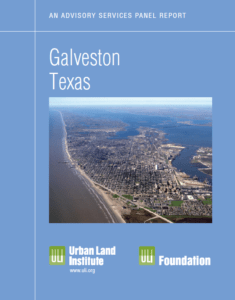Top Story
Location: Galveston, Texas
Sponsor: ULI Foundation
Chair: Smedes York
Subject Area: Disaster Response, Neighborhood Revitalization
For the panel report, please visit ULI’s Knowledge Finder
The Panel’s Assignment
On September 8, 1900, the city of Galveston was hit by the deadliest natural disaster in United States history. Known simply as the 1900 Storm, the hurricane brought winds of 140 mph and storm surges of 15 feet that killed 20 percent of Galveston’s residents and destroyed 36,000 buildings. Galveston rebounded from this disaster by rebuilding its infrastructure, forming a home-rule municipality, and growing its population base to approximately 60,000 residents.
Galveston is located along the Gulf of Mexico, 50 miles south of Houston. The island is now home to employers such as the University of Texas Medical Branch (UTMB), American National Insurance Company, and Texas A&M University at Galveston. Hospitality, food service, and other tourism-related industries provide other major sources of employment and serve Galveston’s 5 million annual visitors.
After more than a century of rebuilding and stabilization, Galveston was hit by another catastrophic natural disaster. On September 13, 2008, Hurricane Ike made landfall on Galveston’s shores with sustained winds of 110 mph and storm surges of 17 feet. Ike ranks as the third most destructive hurricane to make landfall in the United States and is estimated to have caused over $3.5 billion in damage on Galveston Island. After more than six months of cleanup, many Galveston businesses are reopening and Galvestonians are rebounding from catastrophe once again.
Galveston’s Recovery Process
Galveston has taken a proactive approach to recovery. In November 2008 the city council created a committee of residents to define a long-term strategy to chart a course not only to recovery but to future vitality. The committee’s more than 300 members spent over 6,000 hours considering projects and working with the Federal Emergency Management Agency (FEMA) to plan their implementation. On April 9, 2009, the city council voted unanimously to accept the committee’s 42-project Long-Term Community Recovery Plan.
Betty Massey, chair of the committee, described its vision for the future as:
- Building a community that behaves in an environmentally responsible manner, values its natural resources, and protects people, infrastructure, natural resources, and buildings from perils inherent to location on a barrier island;
- Strengthening the economy and diversifying its engines;
- Reconstructing traditional neighborhoods and making the island’s housing stock stronger, safer, more affordable, and more attractive;
- Strengthening and enhancing the effectiveness of the education system;
- Making health care available to everyone;
- Rebuilding and improving infrastructure and transportation systems;
- Keeping Galveston clean and beautiful; and
- Treasuring historical and cultural resources and maintaining the city’s unique character.
The Panel’s Assignment
The city of Galveston invited the ULI panel to consider sustainable neighborhood development strategies—strategies and actions the city should undertake to create healthy, socially diverse, affordable, and resilient neighborhoods for Galveston. In pursuit of this assignment, the city asked the panel to consider two core questions:
- How can we attract residents to live on the island?
- What do we need to do to keep them here?
The panel considered diverse tactics to attract and retain residents to Galveston’s neighborhoods and to encourage investment in both the rehabilitation of historic housing stock as well as the construction of new housing.
Summary of Recommendations
The panel’s recommendations build on the momentum of the recovery plan and lead to one goal: create “one Galveston.” This goal envisions an ecologically sound island community that combines resort living with a revitalized urban core. Defined as the historic neighborhoods east of 61st Street, the urban core will offer diverse housing options for permanent residents. As Galveston moves forward, the panel encourages the community to:
- Focus development efforts in the historic urban core, not undeveloped areas;
- Develop better physical connections within the historic core neighborhoods—especially the Strand, UTMB, and the Seawall—for pedestrians, cyclists, transit passengers, and vehicles;
- Build on existing economic strengths, including UTMB, the Port of Galveston, and tourism;
- •Support entrepreneurship at all levels and leverage the energy of UTMB and its national laboratory to create new businesses and employment on the island; and
- Respect the island’s fragile ecosystem in partnership with federal agencies and other entities vested in the island’s long-term environmental sustainability.
The city of Galveston has the choice to continue to manage decline or invest in its future. The strategic advice suggested in this report will allow the city to create one Galveston while providing that investment in its future that will be the ultimate and positive legacy of Hurricane Ike.
